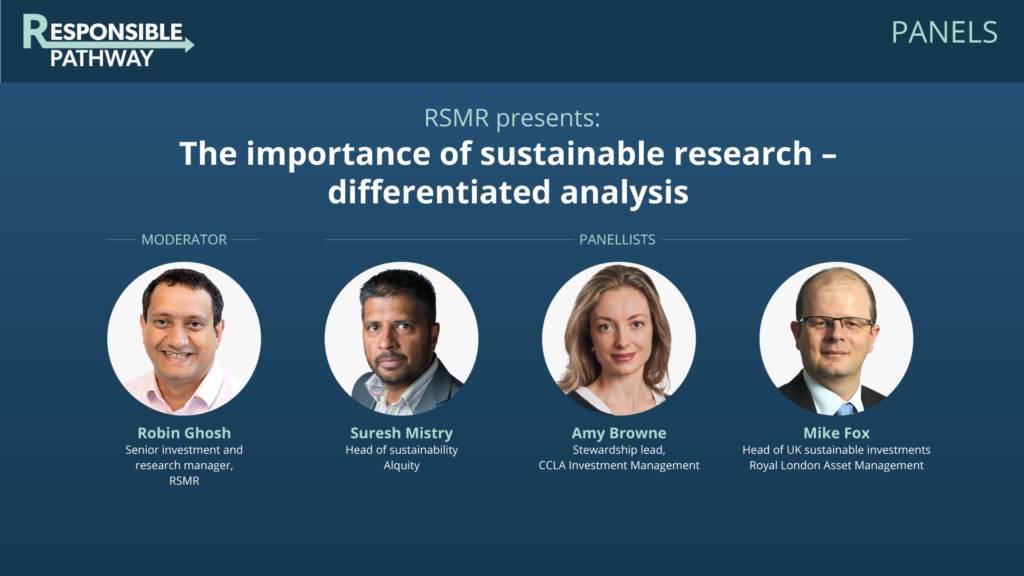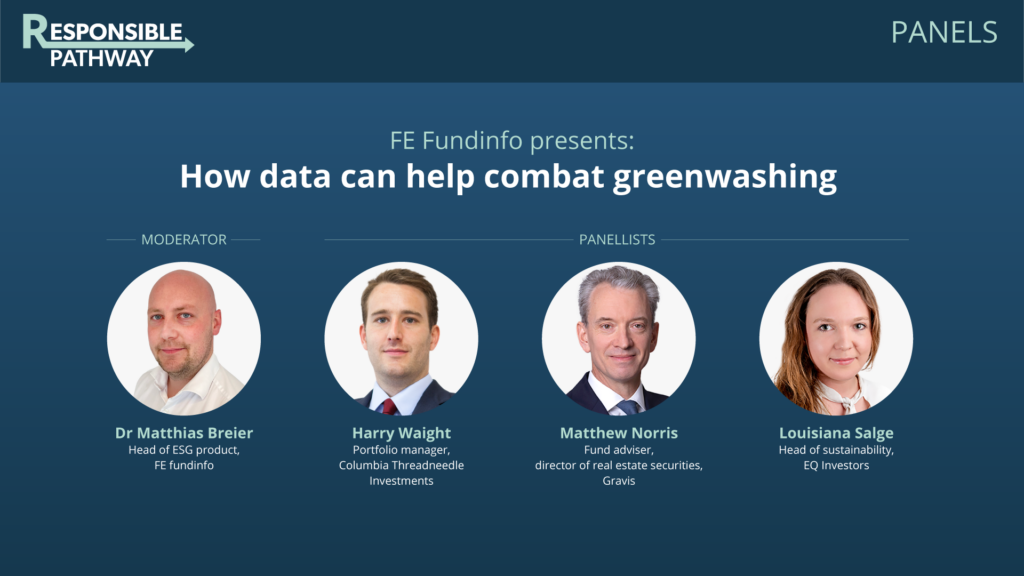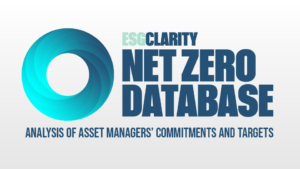Companies have made the mistake of considering ESG as an investment risk metric at the fund level rather than at the company level, according to Suresh Mistry, head of sustainability at Alquity, in the third panel session at Responsible Pathway.
See above video with key takeaways from guests at the event

Held on 6-8 June at Horwood House, Buckinghamshire, in the debate moderated by RSMR’s investment research manager Robin Ghosh the panellists discussed the importance of sustainable research and the different types of analysis.
See also: – Responsible Pathway: Be aware of glossy engagement booklets
“ESG needs to sit next to other risk factors it shouldn’t be used in isolation,” said Mistry.
“Companies have made this mistake last year moving from growth to value. ESG is more like proxy quality management and is an investment risk metric at the company level not at the portfolio level.”
Discussing the data used in their own analysis, the panellists also described how the industry has moved to having too much ESG data after having very little for a long time.
“We are swamped,” said Mike Fox, head of UK sustainable investments RLAM.
“I’m not sure if this is a word but everything has been ‘datafied’. That’s not a good or a bad thing, ultimately, it’s the value you find in it. A lot of life is subjective and rightly so.”
Amy Browne, stewardship lead at CCLA, added: “We have got to a point of having data for the sake of data” and we need to think about where it is really meaningful.
“For example, when you are at school learning history you are forced to learn certain dates. When you get to university and if you are studying history, like I did, you use those dates – or the data – to support your argument.
“This is what us stewardship professionals do every day. Companies won’t listen to us if we don’t have the evidence of data that is key to our work,” she explained.
RLAM’s Fox said transparency is getting better at corporates, and so therefore is the data but this is not the whole picture.
“Data should support the investment case not BE the investment case.
“There are companies out there improving their transparency but are very cold to meet and not personable – that might be an issue, it might not, but ultimately we are trying to build relationships as better relationships have better outcomes.”
Browne also flagged CCLA’s Mental Health Benchmark during the panel and that mental health deterioration is now a global risk as defined by the World Economic Forum and “costs companies billions every year”.
“On average it costs around $1,900 per employee per year. Creating a positive mental health workplace costs a lot less than doing nothing,” she said.
“In 2019, we identified this as a blind spot for sustainable investing and started to engage with FTSE companies – in 2020 we wrote to 100 CEOs urging them to protect employees’ mental health during the pandemic. We received 74 responses eventually. They knew it was a problem and there were lots of initiatives in place – they were trying. But initiatives without strategy is like shooting into space.
“We built a league table for investors to evaluate a company’s approach. This has injected an area of competition that been absent from companies before.”
The firm now has global and UK mental health benchmarks.
“There is a lot of work to do as a lot of companies are still doing very little, we need to turbo charge these and mobilise them into action,” she added.

In the final panel of Responsible Pathway, led by FE Fundinfo’s head of ESG products Dr Matthias Breier, panellists discussed how data can help combat greenwashing.
Louisiana Salge, head of sustainability, shared the approach at EQ Investors: “We have been matching up evidence with intention to kick out the greenwashers.
“We look at the exposure at the asset manager, not just on the fund, so we can be reassured they are staying ahead and not be greenwashing in a year’s time.
“When we start looking at the funds when we have a gap to fill there is a large variety of asset managers. That quickly gets very small from our first conversations and then we take a look at their underlying holdings.
“We need to check them all, and we do check them every month, to check they are adhering to the fund policy.”
Harry Waight, portfolio manager at Columbia Threadneedle Investments, said when looking at companies a stringent and focused approach is also recommended.
“We want as much detail and granularity as possible. If there is a broad net-zero target for 2050 – that raises a red flag. We ask where the interim decarbonisation targets are so we can check if they are meeting them.
“We also ask whether it meets best practice put forward by the Science-Based Targets Initiative and if environmental or social commitments are hard coded into executive remuneration so they have financial skin in the game,” he said.
For real estate investors, Matthew Norris, fund adviser, director of real estate securities at Gravis, said there is a “danger of having too much data” echoing the sentiment of the previous panel.
“As investors in real estate we look at a spectrum of data points but zero in on the ones that have financial impact like EPC ratings. It is not the be all and end all, but it will have an economic impact and a financial consequence to our investors.”
For all panellists, Scope 3 reporting was important but tricky.
Waight said: “There is a huge gap in Scope 3 reporting where the bulk of emissions are coming from. We always encourage companies to do so and have had calls with them to educate on how to measure Scope 3.”
“It is not easy!”, Norris added, while Breier remarked: “We will probably never get 100% accurate Scope 3 data, but it shouldn’t be left out of assessments.”








